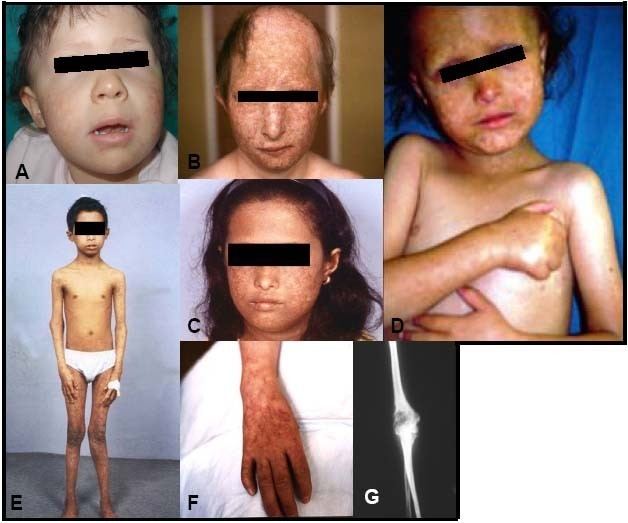Specialty medical genetics ICD-9-CM 757.33 DiseasesDB 29891 | ICD-10 Q82.8 (ILDS Q82.852) OMIM 268400 eMedicine derm/379 | |
 | ||
Rothmund–Thomson syndrome (RTS), also known as poikiloderma atrophicans with cataract or poikiloderma congenitale, is a rare autosomal recessive skin condition originally described by August von Rothmund (1830–1906) in 1868. Matthew Sydney Thomson (1894–1969) published further descriptions in 1936.
Contents
There have been several reported cases associated with osteosarcoma. A hereditary genetic basis, mutations in the DNA Helicase RECQL4 gene, causing problems during initiation of DNA replication has been implicated in the syndrome
Characteristics
The skin is normal at birth. Between 3 and 6 months of age, the affected carrier develops poikiloderma on the cheeks. This characteristic “rash” that all RTS carriers have can develop on the arms, legs and buttocks. “Poikiloderma consists of areas of increased and decreased pigmentation, prominent blood vessels, and thinning of the skin”
Accelerated aging
In humans, individuals with RTS, and carrying the RECQL4 germline mutation, can have several clinical features of accelerated aging. These features include atrophic skin and pigment changes, alopecia, osteopenia, cataracts and an increased incidence of cancer. Also in mice, RECQL4 mutants show features of accelerated aging.
Causes
RTS is caused by a mutation of the RECQL4 gene, located at chromosome 8q24.3. The disorder is inherited in an autosomal recessive manner. This means the defective gene responsible for the disorder is located on an autosome (chromosome 8 is an autosome), and two copies of the defective gene (one inherited from each parent) are required in order to be born with the disorder. The parents of an individual with an autosomal recessive disorder both carry one copy of the defective gene, but usually do not experience any signs or symptoms of the disorder.
DNA repair
RECQL4 has a crucial role in DNA end resection that is the initial step required for homologous recombination (HR)-dependent double-strand break repair. When RECQL4 is depleted, HR-mediated repair and 5’ end resection are severely reduced in vivo. RECQL4 also appears to be necessary for other forms of DNA repair including non-homologous end joining, nucleotide excision repair and base excision repair. The association of deficient RECQL4-mediated DNA repair with accelerated aging is consistent with the DNA damage theory of aging.
